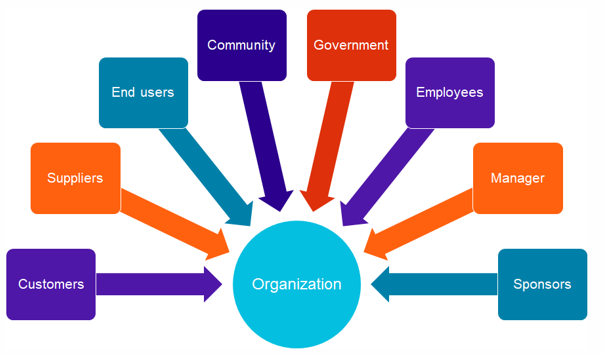Collaborate with stakeholders
Enablers
- Evaluate engagement needs for stakeholders. (ECO 1.9.1)
- Optimize alignment between stakeholder needs, expectations, and project objectives. (ECO 1.9.2)
- Build trust and influence stakeholders to accomplish project objectives. (ECO 1.9.3)
Deliverables, and Tools

Collaboration
- Effective collaboration builds trust between all parties.
- Open dialogue and meaningful communication optimizes the understanding of the aims and expectations.
- Everyone’s involvement and engagement in the project may fluctuate or remain constant.
- Keeping discussions transparent ensures appropriate stakeholders are knowledgeable and expectations are set.
- Communication skills, interpersonal skills, feedback, meeting management, among other management skills, are leveraged to maximize the feedback loop and engagement between stakeholders.
Project Stakeholders

Stakeholder Identification
- Analyze and document relevant information regarding their interest, involvement, interdependencies, influence, and potential impact on project success.
- Available tools and techniques that can be used:
- Expert judgment
- Data gathering
- Questionnaires and surveys
- Brainstorming
- Data analysis
- Stakeholder analysis
- Document analysis
- Data representation
- Stakeholder mapping
- Two-dimensional grids
- Power/interest grid
- Power/influence grid
- Influence/impact grid
- Stakeholder cube
- Directions of influence
- Two-dimensional grids
- Stakeholder mapping
- Meetings
Stakeholder Register
Stakeholder register *: A project document including the identification, assessment, and classification of project stakeholders.

Collaboration Activities
- Stakeholders collaborate every day in a project.
- The frequency of engagement is based on mutual needs and expectations.
- Nearly constant engagement amongst the core project team is common.
- Activities that encourage regular collaboration include:
- Daily stand up meetings
- Co-locating teams near each other for more face-to face communications
- Scheduled sessions such as milestone reviews, backlog grooming sessions, and project update meetings
- Determining and optimizing collaboration activities is an ongoing team effort spearheaded by the project manager
Guidelines for Facilitating a Meeting
- Making certain that the meetings are appropriate to the stakeholder’s engagement in the project.
- Set and distribute an agenda prior to the meeting start.
- Start meetings promptly to support a sense of urgency.
- Review the agenda set prior to the meeting and make amends as stakeholders deem necessary.
- Allow others to speak and share as appropriate.
- Take notes or record the meeting, with permission.
- Keep the meeting discussions on topic. Save outside discussions for after the meeting or for another scheduled meeting with appropriate stakeholders.
- Recap the meeting and any action items to follow the meeting.
- Thank everyone for attending.
- Adjourn the meeting per the scheduled time or earlier.
- Distribute the meeting notes or recording as agreed.
Stakeholder Engagement Plan
The stakeholder engagement plan * is a component of the project management plan that identifies the strategies and actions required to promote productive involvement of stakeholders in project or program decision making and execution.
Guidelines to Develop a Stakeholder Engagement Plan
- Review the project management plan for information such as life cycle selected for the project, description of how work will be executed, description of how resource requirements will be met, how changes will be monitored and controlled, and the need and techniques for communication among stakeholders.
- Review the stakeholder register for information needed to plan appropriate ways to engage project stakeholders.
- Review the organizational culture, structure, and political climate to help in determining the best options to support a better adaptive process for engaging stakeholders.
- Review the lessons-learned database and historical information, as they provide insight on previous stakeholder engagement plans and their effectiveness.
- Use expert judgment to decide upon the level of engagement required at each stage of the project from each stakeholder.
- Hold meetings with experts and the project team to define the required engagement levels of all stakeholders.
- Use analytical techniques to classify the level of engagement for stakeholders.
- Document the stakeholder engagement plan.